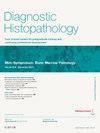男性和女性泌尿生殖道感染性疾病:部分病例的组织学回顾
引用次数: 0
摘要
本综述将描述涉及泌尿生殖道的感染性疾病的组织学特征,并按器官或部位编排。重点放在某些寄生虫、病毒和细菌感染上,这些感染在泌尿生殖道的发生率高于其他部位(血吸虫病),或由于其常见性和与恶性肿瘤的关系(人类乳头瘤病毒)或与盆腔炎的关系(放线菌病)而对病理学家具有特别重要的意义。之所以详细讨论血吸虫病的生命周期和人类乳头瘤病毒的特征,是因为了解它们与人类宿主的相互作用对于理解这些感染的组织学特征非常重要。本文将讨论这些感染的组织学特征,以及可能模拟感染的某些炎症。对于发生在泌尿生殖道的细菌感染和其他病毒感染(其中许多是性传播感染),将只作简要评论,这些感染通常通过组织学检查以外的方法进行诊断,或作为全身感染的一部分累及泌尿生殖道。宫颈细胞学未作讨论。本文章由计算机程序翻译,如有差异,请以英文原文为准。
Infectious diseases of the male and female urogenital tract: a review of the histology of selected entities
This review will describe histological features of infectious diseases involving the urogenital tract, and is organized by organ or location. Emphasis is placed on selected parasitic, viral and bacterial infections that either occur more frequently in the urogenital tract than elsewhere (schistosomiasis), or are of particular importance to the pathologist because of their common occurrence and relation to malignancy (human papillomavirus), or relationship to pelvic inflammatory disease (actinomycosis). Detailed discussions of the life cycle of schistosomiasis and the characteristics of human papillomavirus are included because knowledge of their interactions with the human host is important in order to understand the histological features seen in these infections. The histological features of these infections will be discussed, as well as selected inflammatory conditions that may mimic infection. Only brief comments will be made of bacterial and other viral infections, many of them sexually transmitted, that occur in the urogenital tract and are more commonly diagnosed by means other than histological examination, or may involve the urogenital tract as part of a systemic infection. Cervical cytology is not discussed.
求助全文
通过发布文献求助,成功后即可免费获取论文全文。
去求助
来源期刊

Diagnostic Histopathology
Medicine-Pathology and Forensic Medicine
CiteScore
1.30
自引率
0.00%
发文量
64
期刊介绍:
This monthly review journal aims to provide the practising diagnostic pathologist and trainee pathologist with up-to-date reviews on histopathology and cytology and related technical advances. Each issue contains invited articles on a variety of topics from experts in the field and includes a mini-symposium exploring one subject in greater depth. Articles consist of system-based, disease-based reviews and advances in technology. They update the readers on day-to-day diagnostic work and keep them informed of important new developments. An additional feature is the short section devoted to hypotheses; these have been refereed. There is also a correspondence section.
 求助内容:
求助内容: 应助结果提醒方式:
应助结果提醒方式:


